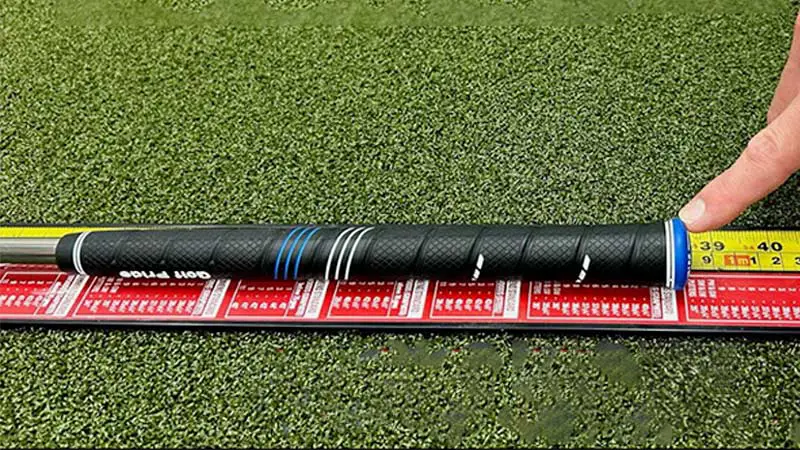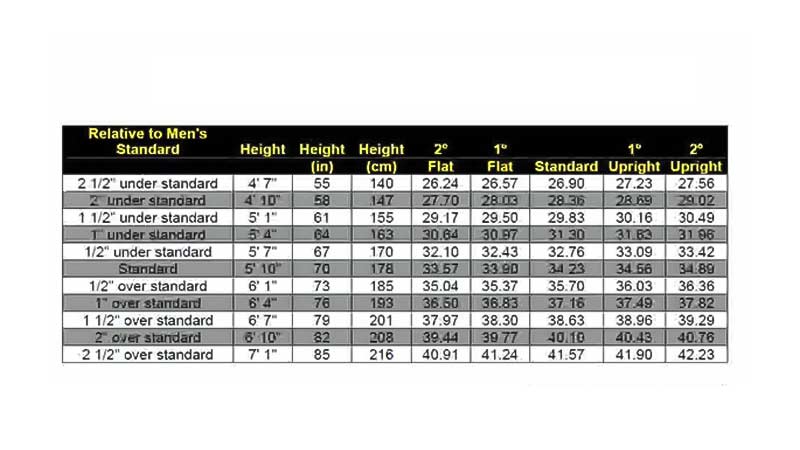Looking for the ultimate guide on selecting the ideal size for your golf clubs? Whether you’re a seasoned golfer looking to fine-tune your equipment or a beginner navigating the vast world of golf gear, understanding the right club size is paramount.
In this comprehensive guide on ‘What size golf clubs do I need: complete guide + charts’, we’ll delve into the factors that influence your club choice and provide you with practical insights to ensure your golfing experience is not just enjoyable but optimized for your unique swing and physique.
Accompanied by easy-to-follow charts, we break down the nuances of club sizing, helping you make informed decisions that can significantly impact your performance on the course.
Get ready to elevate your game as we unravel the mysteries of golf club sizes and how to pick the right one. Let’s tee off on this journey together!
What Size Golf Clubs Do I Need? Complete Guide & Charts

Selecting the right size for your golf clubs is a pivotal aspect of refining your game. Here are the intricacies of determining the ideal size for your golf clubs, accompanied by informative charts to facilitate a clearer understanding.
Factors Influencing Club Size
From your height and swing speed to your skill level, each element plays a crucial role in shaping the ideal set of clubs for your game. Let’s delve into the key factors that influence club size, providing you with insights to elevate your golfing experience.
Height and Posture
The relationship between your height and the length of your golf clubs is fundamental. Taller golfers often find longer clubs beneficial, potentially enhancing their swing mechanics and overall performance.
Conversely, shorter individuals might discover that standard lengths provide better control and comfort. It’s not just about height—consider your posture during the swing, as this factor significantly influences the required length and lie angle of your clubs.
Expanding on this, proper club length and lie angle ensure that your body aligns optimally with the club, promoting a more natural and effective swing.
Experimenting with different lengths based on your height and posture can lead to a noticeable improvement in your overall consistency on the course.
Swing Speed
Your swing speed is a dynamic component that directly impacts club selection. Faster swing speeds benefit from stiffer shafts, a characteristic that facilitates optimal energy transfer during the swing.
This results in increased distance and control. Conversely, slower swing speeds often pair well with more flexible shafts, allowing for enhanced clubhead speed and, consequently, improved distance.
To further illustrate, matching your swing speed with the appropriate shaft flexibility is akin to tuning an instrument for optimal performance.
It ensures that the club responds harmoniously to your swing dynamics, maximizing its effectiveness and your overall game.
Skill Level
Your proficiency on the golf course is a key determinant in choosing the right club size. Beginners, navigating the nuances of the game, may benefit from forgiving and versatile clubs.
These clubs provide a larger sweet spot and increased forgiveness, allowing newcomers to enjoy the learning process with less frustration. On the other hand, advanced players with refined skills might opt for more specialized options.
These clubs cater to specific playing styles, providing the precision and control demanded by seasoned golfers. Tailoring your club selection to your skill level enhances your ability to capitalize on your strengths and address areas for improvement.
Understanding Club Lengths
Knowing the distinctions among driver, irons, and wedges is pivotal in optimizing your game. Here’s the nuanced world of club lengths, breaking down each type and uncovering the considerations that can significantly impact your performance on the course.
Driver
The driver, often the first club off the tee, plays a pivotal role in setting the tone for your round. The standard driver length hovers around 45 inches, providing a balanced mix of distance and control.
However, variations exist to cater to individual preferences and playing styles. Longer drivers have the potential to increase distance, unleashing powerful drives down the fairway. Yet, they may introduce a trade-off with control.
On the flip side, shorter drivers enhance control but might sacrifice some distance. Finding the optimal length for your driver ensures that your tee shots are not only powerful but also consistently accurate.
Expanding on this, consider experimenting with different driver lengths during practice sessions. Assess how each variation aligns with your swing mechanics and desired shot outcomes.
This iterative process will guide you toward the driver length that complements your unique playing style.
Irons
Irons, spanning a range of numbers, each correspond to a specific club in your bag. Understanding the dynamics of iron lengths is crucial for achieving a well-rounded approach to various shots on the course.
Longer irons (2-4) offer greater distance but can be more challenging to hit consistently. Shorter irons (8-PW), on the other hand, provide increased forgiveness and better accuracy, particularly in approach shots to the green.
To illustrate further, envision your irons as a toolkit for different scenarios. Tailoring the length of your irons to the demands of specific shots enhances your ability to navigate the course with precision and confidence.
Wedges
Wedges, including pitching and sand wedges, serve as precision instruments for shots around the green. These clubs are characterized by shorter lengths, providing control for delicate and accurate shots.
The challenge lies in finding the right balance between control and distance when selecting wedges. Delving deeper, mastering wedge play involves understanding the intricacies of partial swings and finesse shots.
Experiment with different wedge lengths to develop a feel for the distances each club covers. This hands-on approach contributes to a nuanced understanding of your wedge arsenal, enabling you to confidently tackle challenging situations around the green.
Using Charts for Reference
Now, let’s delve into the world of charts designed to assist you in determining the perfect size for your golf clubs. From correlating height with club lengths to matching swing speed with shaft flexibility, these charts provide a roadmap for optimizing your equipment.
| Golfer Height | Recommended Driver Length | Recommended Iron Lengths | Recommended Wedge Lengths |
| Under 5’4″ | 44 – 45 inches | Driver: 39″ – 41″ | Irons: 37″ – 38.5″ |
| 5’4″ – 5’7″ | 45 inches | Driver: 41″ – 43″ | Irons: 38.5″ – 39.5″ |
| 5’8″ – 6’1″ | 45 – 46 inches | Driver: 43″ – 44″ | Irons: 39.5″ – 40.5″ |
| Over 6’1″ | 46 inches and above | Driver: 44″ – 46″ | Irons: 40.5″ – 42″ |
Club Length vs. Height Chart
This chart serves as a valuable reference tool, correlating golfer height with recommended club lengths. As a quick reference guide, it aids players of different statures in narrowing down their options.
By aligning your height with the corresponding club lengths, you establish a foundation for your club selection. Keep in mind that this chart provides a starting point, and fine-tuning based on personal feel and preferences is crucial.
Expanding on this, consider the height chart as a baseline that helps you identify a range of suitable club lengths. From this starting point, take the opportunity to experiment with different lengths during practice sessions.
This hands-on approach refines your understanding of how specific lengths complement your unique swing, contributing to a more tailored and effective selection.
Swing Speed and Shaft Flexibility Chart
Matching your swing speed to the appropriate shaft flexibility is an integral step in optimizing your club performance. This chart acts as a guide, ensuring that your clubs respond harmoniously to your individual swing characteristics.
Faster swing speeds benefit from stiffer shafts, promoting optimal energy transfer for increased distance and control. Conversely, more flexible shafts are suitable for slower swing speeds, enhancing clubhead speed and overall performance.
To delve deeper, use the swing speed and shaft flexibility chart to identify the ideal match for your playing style. Recognize that this alignment is not static; it may evolve as your swing mechanics improve or change.
Regularly revisit this chart to ensure your clubs continue to maximize your potential on the course.
Fine-Tuning Your Selection
While charts offer valuable insights, personalizing your club selection involves hands-on experimentation. Visit the driving range armed with the knowledge gained from the charts, and assess how different club sizes align with your unique swing mechanics.
Remember, the feel of a club in your hands is just as important as the data on a chart. For a tailored approach, consider consulting with a professional club fitter.
Their expertise can provide in-depth insights into your swing, leading to recommendations that elevate your game.
As you navigate the intersection of charts and personal preference, may each swing bring you closer to a perfectly tuned set of clubs tailored to your golfing journey.
FAQs
What happens if my golf clubs are too long or too short?
Golf clubs that are too long may lead to loss of control, while those that are too short can affect power and distance. Properly fitted clubs enhance consistency and performance.
How can I determine my ideal club length without professional assistance?
Utilize height charts and swing speed guidelines as a starting point. Experiment with different lengths on the driving range, focusing on comfort, control, and overall feel to fine-tune your selection.
Does swing speed only affect driver shaft flexibility, or does it apply to all clubs?
While swing speed is crucial for driver shaft selection, it also influences shaft flexibility in other clubs. Faster swings generally benefit from stiffer shafts, promoting consistency and control throughout the set.
Are there recommended club lengths for women and men, or is it solely based on height and swing speed?
While height and swing speed are primary factors, gender-specific recommendations exist. Generally, women may benefit from slightly shorter and more flexible shafts, but individual fitting based on height and swing speed remains crucial.
Can a professional club fitting improve my game, and how does it differ from using charts?
Yes, a professional fitting provides personalized insights by analyzing your swing dynamics. While charts offer general guidelines, professional fittings consider nuances like ball flight, impact position, and individual preferences for a more tailored approach.
Conclusion
Finding the perfect size for your golf clubs is a crucial step toward enhancing your game. By understanding the nuances of club sizing, you empower yourself to make informed decisions that align with your individual playing style and physical attributes.
The comprehensive guide and accompanying charts provided here serve as valuable tools to navigate the complexities of selecting the right clubs. Follow it to get the perfect club for a perfect swing in the field.
Remember, there’s no one-size-fits-all solution, and experimentation coupled with this knowledge will lead you to a setup that feels tailor-made for your swing.
As you embark on your golfing journey armed with this newfound wisdom, may your drives be powerful, your approach shots precise, and your overall enjoyment of the game reach new heights. Cheers to a well-fitted set of clubs and countless successful rounds on the horizon!








Colin McCarthy